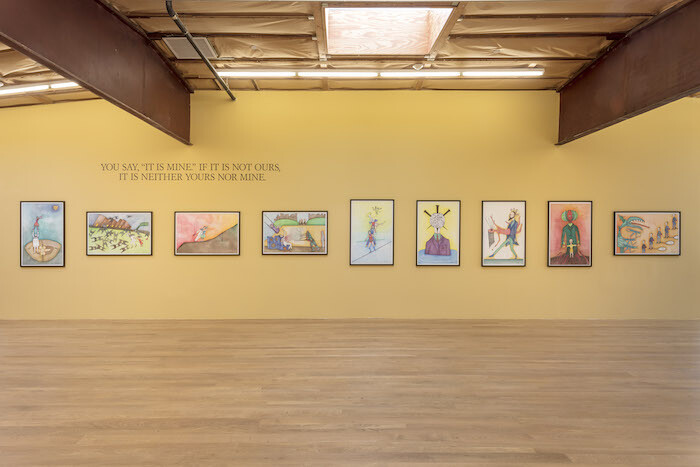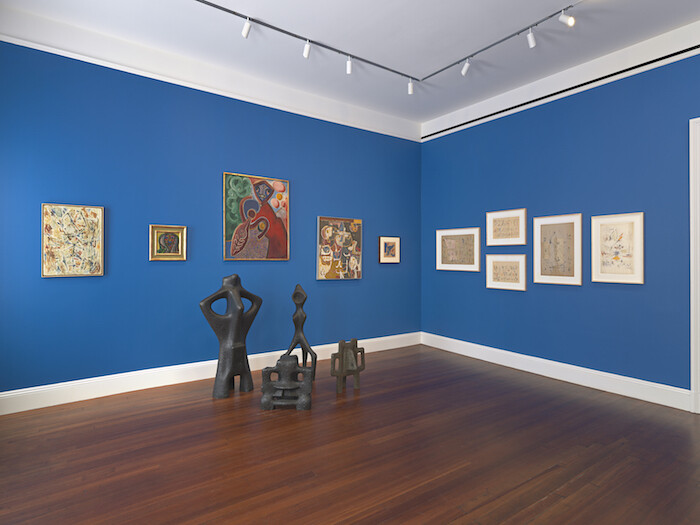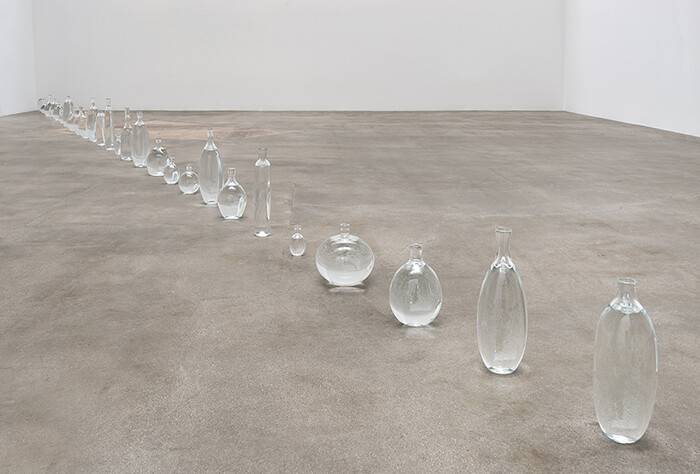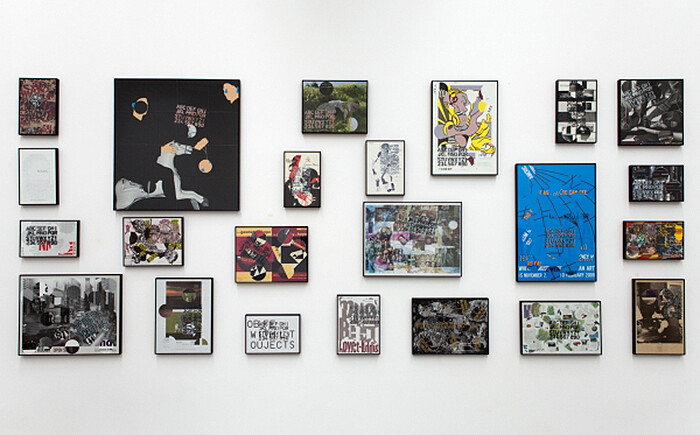Categories
Subjects
Authors
Artists
Venues
Locations
Calendar
Filter
Done
February 7, 2018 – Review
pascALEjandro’s “Alchemical Love”
Andrew Berardini

For true mystics, there is no division between the real and the spiritual. The symbolic folds into our lives, shaping the world and us in it. The cool kiss of rain can be a curse or a blessing from the gods. Stumbling in the street en route to meet your lover might signal deeper misgivings and potential pratfalls of your coupling. Rather than a pseudoscience, astrology can, in tracking the paths of celestial bodies, chart our hidden natures. The card flourished from the tarot deck for many unveils the true shape and contour of a life: its past, present, and future. To practitioners and adherents of the esoteric, the interior and the exterior, the natural and the supernatural are one. “As above, so below,” to quote the legendary father of alchemy, Hermes Trismegistus.
Drawn by filmmaker Alejandro Jodorowsky and colored by costume designer/artist Pascale Montandon-Jodorowsky, the drawings that make up “Alchemical Love,” conceived and realized by this married couple (under the portmanteau of their two first names pascALEjandro), reveal a world of magical forces shaping their lives, a spirituality that weds the deeper mysteries to their love story. They are deceptively simple, each strange scene almost pulled from a children’s book …
May 4, 2016 – Review
Robert Morris & Kishio Suga
Stuart Munro

Words, like the gray matting in Robert Morris’s Lead and Felt (1969/2016), are woven. Yet, like these felt strips, descriptions shift. In a shared context with Kishio Suga’s Parameters of Space (1978/2016), material and form take on meanings that bend, twist, and track the local climate. The immediate world provides a particular field of reference, the imperfect translation of one language into another. Moving between objects positioned by hand, you can’t help but be aware of their interest in borders and boundaries.
Lead and Felt was originally made for an exhibition at Castelli Gallery in New York, after which it was lost and then remade. Morris came to interpret L-shaped lead and felt strips in later life as an echo of another work created for the show, Scatter Piece (also 1969), that also went missing. Whether exhibited, stored, or thrown into some distant landfill, they became an expression of how transient objects are and how resilient an idea can be. The original Scatter Piece is buried somewhere in New Jersey, casting what Morris describes as a “shadow” over later iterations.
Parameters of Space was made for Kishio Suga’s 1978 solo exhibition at Gallery Saiensu, in Morioka. His interest in borders was laid …
October 16, 2015 – Review
“The Avant-Garde Won’t Give Up: Cobra and Its Legacy”
Rachel Wetzler

Cobra, a short-lived association of artists based in Copenhagen, Brussels, and Amsterdam who published an eponymous journal from 1948 to 1951, has the dubious honor of being frequently invoked as a locus of postwar avant-garde activity in Europe, while its works remain all but invisible outside of the group’s native northern Europe. The two-part exhibition “The Avant-Garde Won’t Give Up: Cobra and Its Legacy,” split between Blum & Poe’s New York and Los Angeles locations, aims to be a corrective to this invisibility, as well as to the dominant understandings of Cobra as merely a Situationist precursor or, worse, a minor regional variant on Abstract Expressionist and Informel painting.
The first half of the exhibition, in New York, is a historical survey primarily comprising works from the 1940s and ’50s. It opens with Cobra member Asger Jorn’s painting L’avant-garde ne se rend pas, from which the exhibition takes its title. Part of his 1962 series “New Disfigurations,” found flea-market canvases overlain with childlike doodles and gestural marks, it is a vulgarized portrait of a young girl, redolent of Biedermeier kitsch, to which Jorn has added slightly menacing stick figures and, in a pastiche of Duchamp, a moustache. The titular slogan, scrawled …
July 29, 2014 – Review
David Horvitz
Andrew Berardini

Irregularly and perhaps just a bit irrationally, lawmakers and treaties carve hard demarcations of time from a spinning globe. Workers clock in there, the lunch hour is now here—Daylight Savings Time always confused the hell out of me. Whatever you think noon is, it’s now mostly an abstraction. Time zones emerged out of a need for the trains to keep schedules across long distances, and from the beginning, citizens resisted the co-opting of true time (noon being when the sun is directly overhead), but every country and territory now falls into some imaginary space of time.
The most beautiful of these lines drunkenly dances across the Pacific Ocean, shimmying back and forth across the 180th meridian, the International Date Line. It shifts a calendar with each tick past midnight, dismissing a dead year with the popping the first bubbly on New Year’s. But a few longitudinal notches east an imaginary line of time squiggles around the American state of Alaska, separating it from the Pacific Standard Time that governs Western Canada, the Western United States, a sliver of Mexican Baja California, and a smattering of South Pacific Islands claimed by France, the United Kingdom, and Mexico. Though few clocks are kept …
September 4, 2012 – Review
"Standard Operating Procedures"
Jonathan Griffin

With Tina Braegger, Antoine Catala, Ida Ekblad, Nikolas Gambaroff, Nicolas Guagnini, Yngve Holen, Alex Israel, Helen Marten, John Miller, Olivier Mosset, Amy O’Neill, Sean Paul, Carissa Rodriguez, Greg Parma Smith, Alan Uglow, and Hannah Weinberger.
What is the difference between a “standard operating procedure” and a formula, an algorithm, a set of instructions, a program, a system, a recipe or a run book? This exhibition, which takes SOPs as its theme, never makes it quite clear. But its curator, Piper Marshall, contends in her press release that “Today, SOPs are determining the conditions of everyday life,” through such esoteric formulations as search engines, dating sites, self-help books, and targeted advertising.
Artists have applied rules and systems to the manufacture of their work (at least) since Marcel Duchamp dropped pieces of thread to make Three Standard Stoppages (1913). Painters such as Josef Albers, Alfred Jensen, and Ad Reinhardt distilled painting to a programmatic sequence of actions. Conceptualists including Sol LeWitt and Lawrence Weiner took their methods still further, sometimes to the extent that the rules became the work itself.
Marshall’s exhibition acknowledges this legacy, but is not in thrall to it. We never find out how rigorously obedient the included works …
